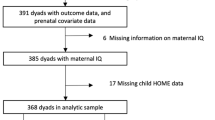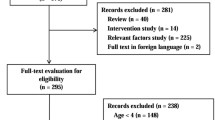Abstract
Objectives Children born to teenage mothers are at risk for more physical and cognitive problems than those born to adult mothers. Our objective was to examine differences in size and intelligence between two cohorts of offspring born to adolescent (n = 357) and adult mothers (n = 668) who attended the same prenatal clinic. Methods Two prospective study cohorts assessed children from gestation through age 6 years. The adult cohort was studied in the mid-1980’s and the teen cohort was evaluated in the mid-1990’s. Both samples were of low socio-economic status. The same study design and measures allowed us to adjust for the covariates of size and IQ. Results Offspring of adolescent mothers had a significantly smaller mean head circumference (5 mm) (HC) and higher body mass index (BMI) than offspring of adult mothers. Offspring of adolescent mothers scored significantly lower than the offspring of adult mothers on the Stanford-Binet (SBIS) composite score (4 points), and the quantitative (6.2 points), verbal reasoning (4.8 points), and short-term memory (3.9 points) area scores. Additional predictors of child IQ were maternal IQ, home environment, race, and number of siblings. When child HC was entered into our final regression model for the SBIS, maternal age and HC significantly predicted the composite score, the verbal reasoning, and short-term memory area scores. A 1 cm decrease in HC predicted a 1 point decrease in the SBIS composite score. Conclusions Compared to offspring of adult women, children of adolescent mothers have lower mean scores on cognitive measures, smaller head circumference, and higher BMI. These differences were significant after adjusting for differences between the two groups. Adolescent mothers and their children would benefit from interventions such as parenting support, education about nutritional needs, and advice on enriching the environments of their children.

Similar content being viewed by others
References
Brown, H., Fan, Y., & Gonsoulin, W. (1991). Obstetric complications in young teenagers. Southern Medical Journal, 84(1), 46–48.
Fraser, A., Brockert, J., & Ward, R. (1995). Association of young maternal age with adverse reproductive outcomes. The New England Journal of Medicine, 332, 1113–1117. doi:10.1056/NEJM199504273321701.
Klein, J. (2005). Adolescent pregnancy: Current trends and issues. Pediatrics, 116, 281–286. doi:10.1542/peds.2005-0999.
Sommer, K., Whitman, T., Borkowski, J., Gondoli, D., Burke, J., Maxwell, S., et al. (2000). Prenatal maternal predictors of cognitive and emotional delays in children of adolescent mothers. Adolescence, 35, 87–112.
Kongnyuy, E., Nana, P., Fomulu, N., Wiysonge, S., Kouam, L., & Doh, A. (2008). Adverse perinatal outcomes of adolescent pregnancies in Cameroon. Maternal and Child Health Journal, 12, 149–154. doi:10.1007/s10995-007-0235-y.
Ketterlinus, R., Henderson, S., & Lamb, M. (1990). Maternal age, sociodemographics, prenatal health and behavior: Influences on neonatal risk status. Journal of Adolescent Health Care, 11, 423–431. doi:10.1016/0197-0070(90)90090-O.
Byrd, R., & Weitzman, M. (1994). Predictors of early grade retention among children in the United States. Pediatrics, 93(3), 481–487.
Coley, R., & Chase-Lansdale, P. (1998). Adolescent pregnancy and parenthood: Recent evidence and future directions. The American Psychologist, 53(2), 152–166. doi:10.1037/0003-066X.53.2.152.
Corcoran, J. (1998). Consequences of adolescent pregnancy/parenting: A review of the literature. Social Work in Health Care, 27, 49–67.
Miller, C., Miceli, P., Whitman, T., & Borkowski, J. (1996). Cognitive readiness to parent and intellectual-emotional development in children of adolescent mothers. Developmental Psychology, 32, 533–541. doi:10.1037/0012-1649.32.3.533.
Moore, K., Morrison, D., & Greene, A. (1997). Effects on the children born to adolescent mothers. In R. A. Maynard (Ed.), Kids having kids: Economic costs and social consequences of teen pregnancy (pp. 145–180). Washington, DC: Urban Institute Press.
Dahinten, V., Shapka, J., & Wilms, D. (2007). Adolescent children of adolescent mothers: The impact of family functioning on trajectories of development. Journal of Youth and Adolescence, 36(2), 195–212. doi:10.1007/s10964-006-9140-8.
Turley, R. (2003). Are children of young mothers disadvantaged because of their mother’s age or family background? Child Development, 74, 465–474. doi:10.1111/1467-8624.7402010.
Williams, L., & Decoufle, P. (1999). Is maternal age a risk factor for mental retardation among children? American Journal of Epidemiology, 149(9), 814–823.
Fergusson, D., & Woodward, L. (1991). Maternal age and educational and psychosocial outcomes in early adulthood. Paediatric and Perinatal Epidemiology, 43(3), 479–489.
Day, N., Richardson, G., Geva, D., & Robles, N. (1994). Alcohol, marijuana, and tobacco: Effects of prenatal exposure on offspring growth and morphology at age six. Alcoholism, Clinical and Experimental Research, 18, 786–794. doi:10.1111/j.1530-0277.1994.tb00041.x.
Cornelius, M., Goldschmidt, L., Day, N., & Larkby, C. (2002). Prenatal substance use among pregnant teenagers: A six-year follow-up of effects on offspring growth. Neurotoxicology and Teratology, 24, 703–710. doi:10.1016/S0892-0362(02)00271-4.
Brenner, W., Edelman, D., & Hendricks, C. (1976). A standard of fetal growth for the United States of America. American Journal of Obstetrics and Gynecology, 126, 555–564.
Centers for Disease Control and Prevention (CDC), National Center for Health Statistics (NCHS). (2000). National health and nutrition examination survey data. Hyattsville, MD: U.S. Department of Health and Human Services, Centers for Disease Control and Prevention. http://www.cdc.gov/nchs/about/nchs_accessibility.htm.
Thorndike, R., Hagen, E., & Sattler, J. (1986). The Stanford-Binet Intelligence Scale (4th ed.). Chicago, IL: Riverside Publ Co.
Willford, J., Leech, S., & Day, N. (2006). Moderate prenatal alcohol exposure and cognitive status of children at age 10. Alcoholism, Clinical and Experimental Research, 30(6), 1051–1059. doi:10.1111/j.1530-0277.2006.00119.x.
Baker, P., & Mott, F. (1989). National longitudinal study of youth child handbook. Center for Human Resource Research: Ohio State University.
Frankenburg, W., & Coons, C. (1986). The home screening questionnaire: Its validity in assessing home environment. The Journal of Pediatrics, 108, 624–626. doi:10.1016/S0022-3476(86)80853-8.
Caldwell, B., & Bradley, R. (1984). Home observation for measurement of the environment. Little Rock: University of Arkansas at Little Rock.
Wechsler, D. (1991). Wechsler Intelligence Scale for Children (3rd ed.). San Antonio, TX: Psychological Corporation.
Tong, S., Baghurst, P., Vimpani, G., & McMichael, A. (2007). Socioeconomic position, maternal IQ, home environment, and cognitive development. The Journal of Pediatrics, 151, 284–288. doi:10.1016/j.jpeds.2007.03.020.
Lawlor, D., Batty, G., Morton, S., Deary, I., Macintyre, S., Ronalds, G., et al. (2005). Early life predictors of childhood intelligence: Evidence from the Aberdeen children of the 1950’s study. Journal of Epidemiology and Community Health, 59, 566–663.
Radloff, L. (1977). The CES-D scale: A self-report depression scale for research in the general population. Applied Psychological Measurement, 1, 385–401. doi:10.1177/014662167700100306.
Myers, J., & Weissman, M. (1980). Use of a self-report symptom scale to detect depression in a community sample. The American Journal of Psychiatry, 137, 1081–1084.
Fisch, R., Bilek, M., Horobin, J., & Chang, P. (1976). Children with superior intelligence at 7 years of age. American Journal of Diseases of Children, 130, 481–487.
Gale, C., O’Callaghan, J., Bredow, M., & Martyn, C. (2007). The influence of head growth in fetal life, infancy, and childhood on intelligence at ages 4 and 8 years. Pediatrics, 118(4), 1486–1492. doi:10.1542/peds.2005-2629.
Gale, C., O’Callaghan, F., Godfrey, K., & Law, C. (2004). Critical periods of brain growth and cognitive function in children. Brain, 127, 321–329. doi:10.1093/brain/awh034.
Wang, Y., & Lobstein, T. (2006). Worldwide trends in childhood overweight and obesity. International Journal of Pediatric Obesity; IJPO, 1(1), 11–25. doi:10.1080/17477160600586747.
Brooks-Gunn, J., & Chase-Lansdale, P. (1986). The children of adolescent mothers: Physical, academic and psychological outcomes. Developmental Review, 6, 224–251. doi:10.1016/0273-2297(86)90013-4.
Farthing, M. (1991). Current eating patterns of adolescents in the United States. Nutrition Today, 26, 35–39. doi:10.1097/00017285-199103000-00008.
Gordon-Larsen, P., Adair, L., Nelson, M., & Popkin, B. (2004). Five-year obesity incidence in the transition period between adolescence and adulthood: The national longitudinal study of adolescent health. The American Journal of Clinical Nutrition, 80, 569–575.
Flegal, K., & Troiano, R. (2000). Changes in the distribution of body mass index of adults and children in the US population. International Journal of Obesity, 24, 807–818. doi:10.1038/sj.ijo.0801232.
Shaw, P., Greenstein, D., Lerch, J., Clasen, L., Lenroot, R., Gogtay, N., et al. (2006). Intellectual ability and cortical development in children and adolescents. Nature, 440(30), 676–679. doi:10.1038/nature04513.
Bennett, E., Diamond, M., Krech, D., & Rosenzweig, M. (1964). Chemical and anatomical plasticity brain. Science, 146, 610–619. doi:10.1126/science.146.3644.610.
Markham, J., & Greenough, W. (2004). Experience-driven brain plasticity: Beyond the synapse. Neuron Glia Biology, 1(4), 351–363. doi:10.1017/S1740925X05000219.
Wickett, J., Vernon, P., & Lee, D. (2000). Relationships between factors of intelligence and brain volume. Personality and Individual Differences, 29, 1095–1122. doi:10.1016/S0191-8869(99)00258-5.
Hack, M., Breslau, N., Weissman, B., Aram, D., Klein, N., & Borawski, E. (1991). Effect of very low birth weight and subnormal head size on cognitive abilities at school age. The New England Journal of Medicine, 325, 231–237.
Ounsted, M., Moar, V., & Scott, A. (1988). Head circumference and developmental ability at the age of 7 years. Acta Paediatrica Scandinavica, 77, 374–379. doi:10.1111/j.1651-2227.1988.tb10663.x.
Reiss, A., Abrams, M., Singer, H., Ross, J., & Denckla, M. (1996). Brain development, gender and IQ in children. A volumetric imaging study. Brain, 119, 1763–1774. doi:10.1093/brain/119.5.1763.
Anderson, L., Fullilove, M., Scrimshaw, S., Fielding, J., Normand, J., & Carande-Kulis, V. (2003). The effectiveness of early childhood development programs. A systematic review. American Journal of Preventive Medicine, 24(3), 32–46. doi:10.1016/S0749-3797(02)00655-4.
Eickmann, S., Lima, A., Guerra, M., Lima, M., Lira, P., Huttly, S., et al. (2003). Improved cognitive and motor development in a community-based intervention of psychosocial stimulation in northeast Brazil. Developmental Medicine and Child Neurology, 45(8), 536–541. doi:10.1017/S0012162203000987.
Hill, J., Brooks-Gunn, J., & Waldfogel, J. (2003). Sustained effects of high participation in an early intervention for low-birth-weight premature infants. Developmental Psychology, 39, 730–744. doi:10.1037/0012-1649.39.4.730.
Furstenberg, F., Levine, J., & Brooks-Gunn, J. (1990). The children of teenage mothers: Patterns of early childbearing in two generations. Family Planning Perspectives, 22, 54–61. doi:10.2307/2135509.
Hechtman, L. (1989). Teenage mothers and their children: Risks and problems: A review. Canadian Journal of Psychiatry, 34, 569–574.
Osofsky, J., Culp, A., & Ware, L. (1988). Intervention challenges with adolescent mothers and their infants. Psychiatry, 51, 236–241.
Becker, P. (1987). Sensitivity to infant development and behavior: A comparison of adolescent and adult single mothers. Research in Nursing and Health, 10, 119–127. doi:10.1002/nur.4770100303.
Newberger, E. (1983). The helping hand strikes again: The unintended consequences of child abuse reporting. Journal of Clinical Child Psychology, 12, 307–311. doi:10.1207/s15374424jccp1203_13.
Cole, T. J. (2000). Secular trends in growth. The Proceedings of the Nutrition Society, 59(2), 317–324.
Dolman, J., & Olds, T. S. (2006). Secular changes in fatness and fat distribution in Australian children matched for body size. International Journal of Pediatric Obesity; IJPO, 1(2), 109–113. doi:10.1080/17477160600684260.
Hauspie, R., Vercauteren, M., & Susanne, C. (1997). Secular changes in growth and maturation: An update Acta Paediatrica (Oslo, Norway), 423, 20–27.
Ogden, C., Carroll, D., Curtin, L., McDowell, M., Tabak, C., & Flegal, K. (2006). Prevalence of overweight and obesity in the United States, 1999–2004. Journal of the American Medical Association, 295, 1549–1555. doi:10.1001/jama.295.13.1549.
Lynn, R., & Pagliari, C. (1994). The intelligence of American children is still rising. Journal of Biosocial Science, 26, 65–67.
Acknowledgements
This study was supported by grants from the National Institute of Drug Abuse (DA03874 PI: N Day; DA09275 PI: M Cornelius) and the National Institute on Alcohol Abuse and Alcoholism (AA06666 PI: N Day; AA08284; PI: M Cornelius). The authors thank the young women and children who made this study possible by contributing their time and sharing their experiences with our interviewers and field staff.
Author information
Authors and Affiliations
Corresponding author
Rights and permissions
About this article
Cite this article
Cornelius, M.D., Goldschmidt, L., Willford, J.A. et al. Body Size and Intelligence in 6-year-olds: Are Offspring of Teenage Mothers at Risk?. Matern Child Health J 13, 847–856 (2009). https://doi.org/10.1007/s10995-008-0399-0
Received:
Accepted:
Published:
Issue Date:
DOI: https://doi.org/10.1007/s10995-008-0399-0




